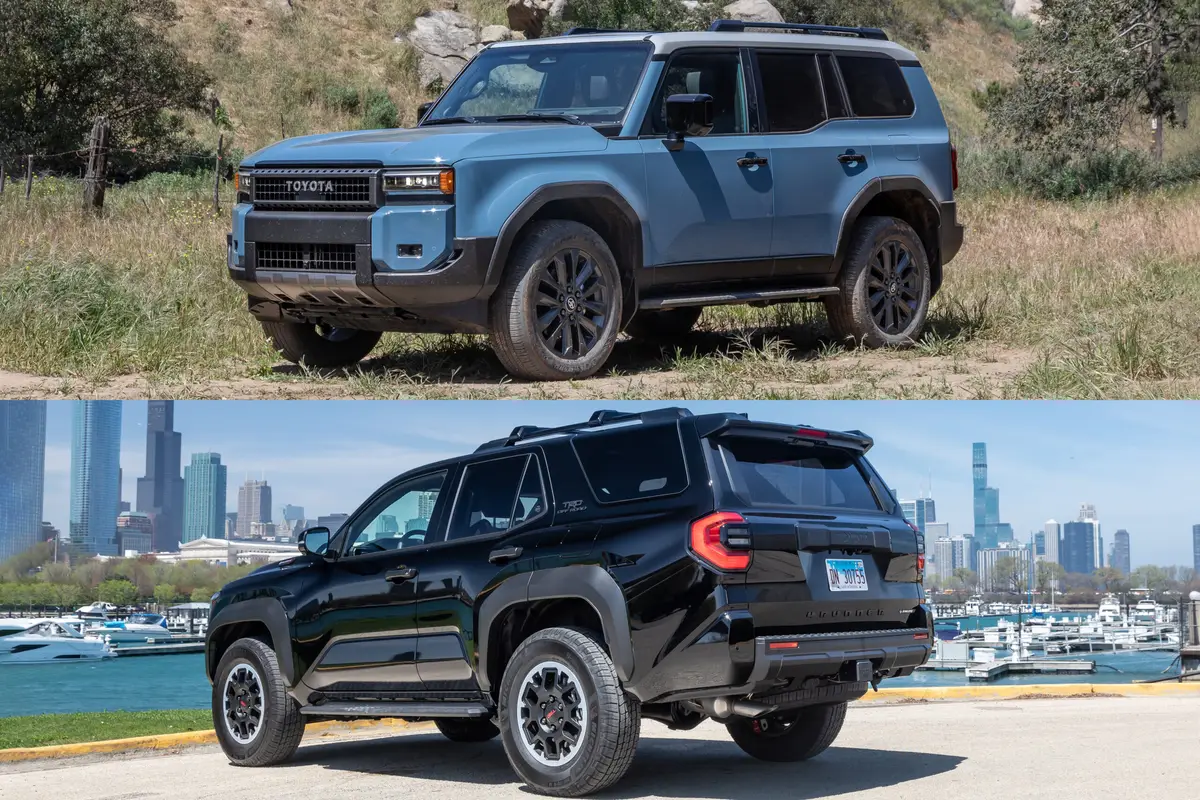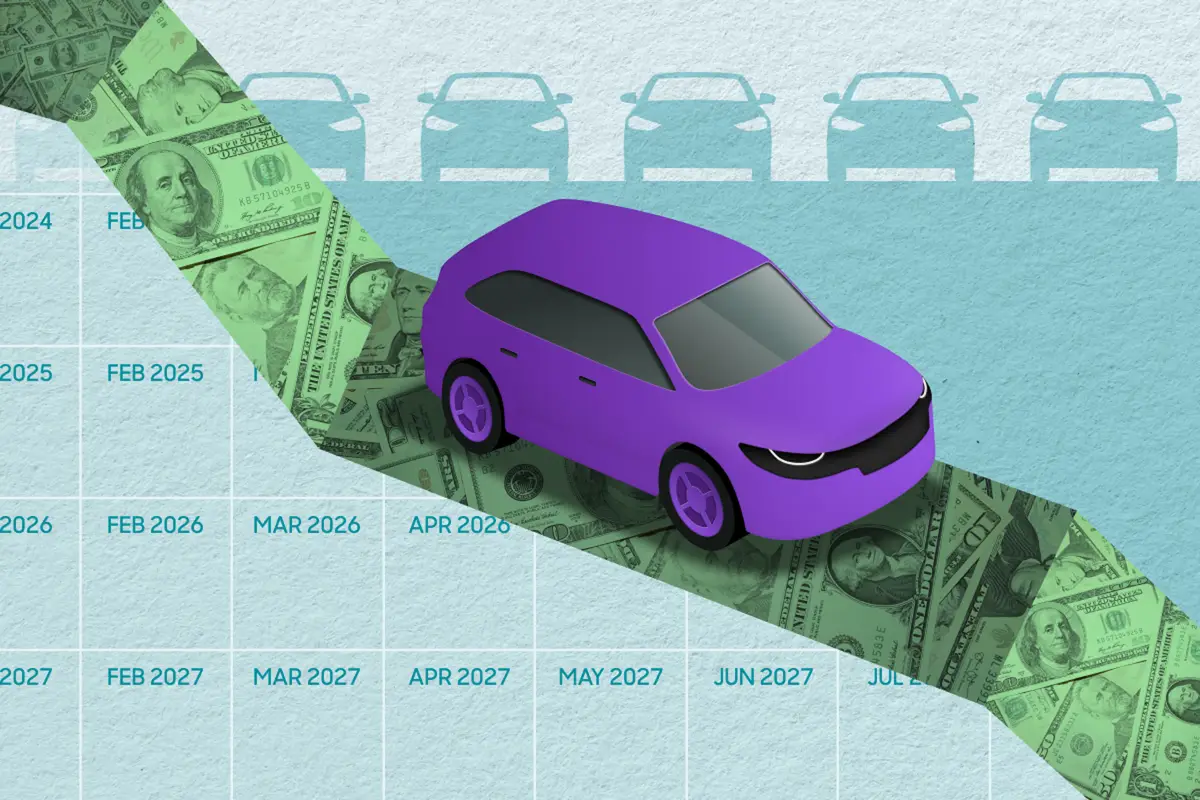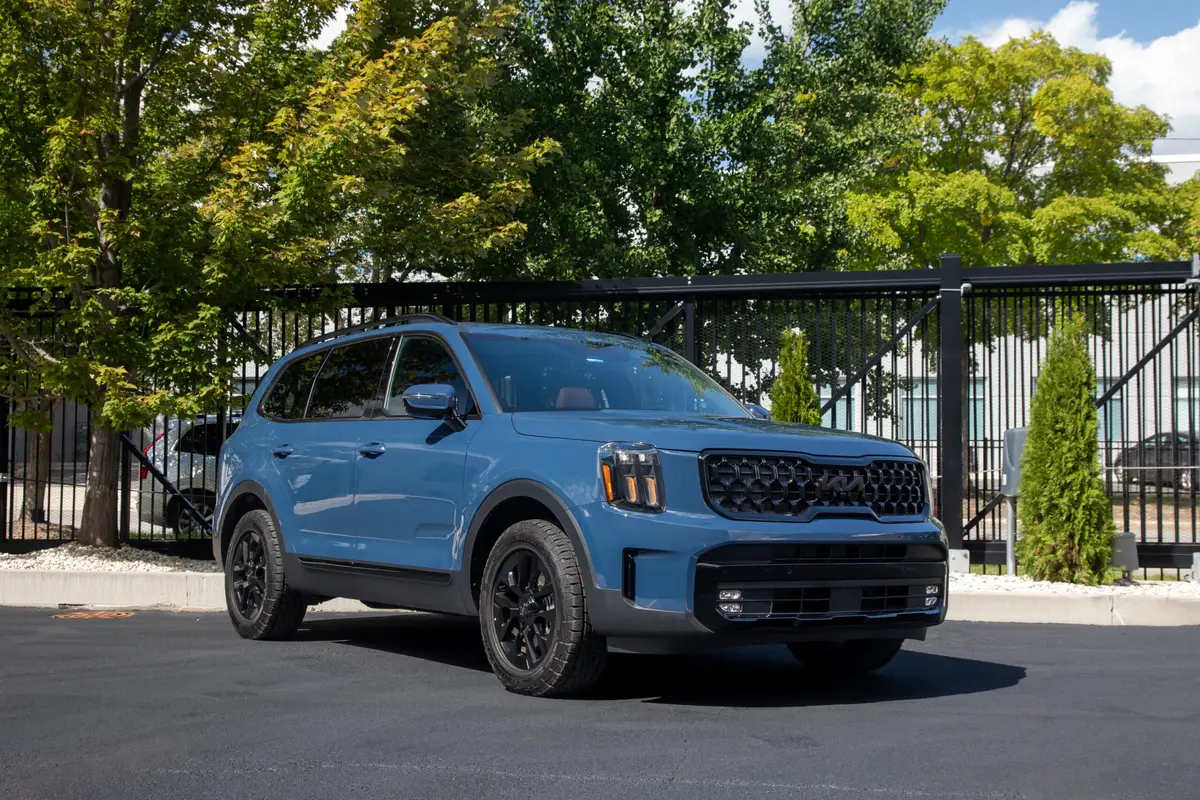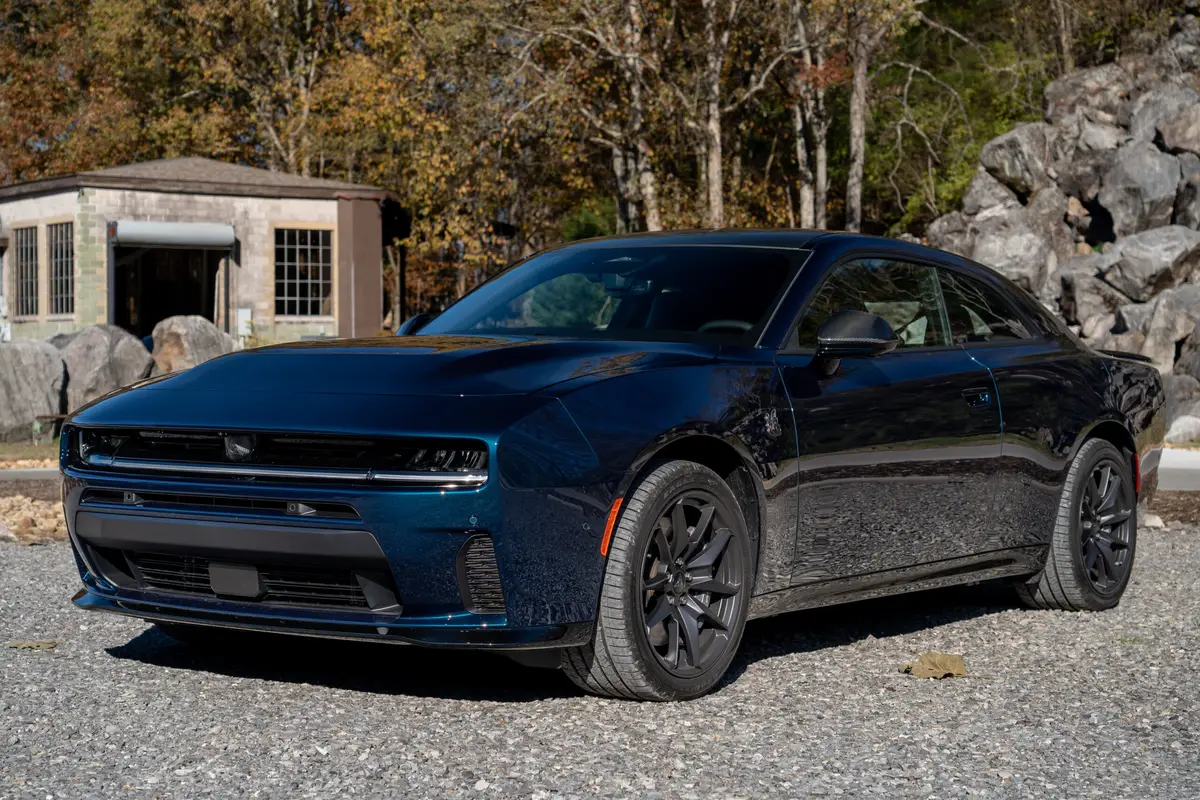2025 Toyota Land Cruiser Premium Vs. 2025 Toyota 4Runner TRD Off-Road Premium


Key Points
- The 2025 Toyota Land Cruiser is more comfortable and composed on pavement, more luxurious and roomy inside, and its standard hybrid powertrain is just as efficient as the 4Runner hybrid’s — but it’s also significantly more expensive.
- Our 2025 Toyota 4Runner TRD Off-Road Premium is lacking in most areas compared to the Land Cruiser, though it does have a larger center touchscreen. Don’t forget about five figures’ worth of savings, either.
One of the biggest questions for Toyota following the Land Cruiser’s return and the 4Runner’s redesign was how the two would fit in the same lineup with seemingly so much overlap. After driving a 2025 Land Cruiser Premium and comparing it to our long-term 2025 4Runner hybrid TRD Off-Road Premium, it’s safe to say that these are still two distinct off-road SUVs — but there’s still a lot of overlap.
Related: 2025 Toyota 4Runner Review: Time for Some Soul Searching
Both SUVs have the same hybrid powertrain: a 326-horsepower, turbocharged 2.4-liter four-cylinder gas-electric hybrid system paired with an eight-speed automatic transmission. The Land Cruiser has full-time four-wheel drive with electronic-locking center and rear differentials, while the 4Runner’s 4WD is part-time, and it only has an electronic-locking rear differential. Inside, the 4Runner and Land Cruiser are both two-row SUVs, though the non-hybrid 4Runner is available with a third row.
| 2025 Land Cruiser Premium | 2025 4Runner TRD Off-Road Premium | |
|---|---|---|
| Engine | 326-hp, turbo 2.4-liter four-cylinder gas-electric hybrid | 326-hp, turbo2.4-liter four-cylinder gas-electric hybrid |
| Transmission | Eight-speed automatic | Eight-speed automatic |
| Driveline | Full-time 4WD with electronic-locking center and rear differentials | Part-time 4WD with low range and electronic-locking rear differential |
| Ground clearance (inches) | 8.7 | 9.1 |
| Combined mpg rating | 23 | 23 |
| As-tested price (including destination) | $73,344 | $61,219 |
Besides a more sophisticated 4WD system in the Land Cruiser, the most significant differentiator between these two SUVs is price: As tested, the Land Cruiser carries a $73,344 price tag, while the 4Runner is more than $12,000 less at $61,219 (all prices include destination fee). Other differences are fairly minimal. The two SUVs have different layouts for their respective climate and audio controls as well as for their off-road systems. While each runs the same infotainment software, the 4Runner’s display is 14 inches, while the Land Cruiser’s is 12.3 inches. Which one is right for you? I’ll discuss which is better on-road, which interior I prefer and which is more prepared for off-roading.
- ${price_badge()}
- ${ami_badge()}
- ${battery_badge()}${ev_report_link()}
- ${hot_car_badge()}
- ${award_badge()}
- ${cpo_badge()}
${price_badge_description}
${ami_badge_description}
The EV Battery Rating is based on this vehicle's current expected range relative to the vehicles expected range when new. ${battery_badge_text}
This vehicle is certified pre-owned, backed by a manufacturer warranty, and typically undergoes a rigorous multi-point inspection to ensure quality and reliability.
This vehicle is currently in high demand given its competitive price, desirable features, and overall condition, and may have a higher chance of selling quickly.
Shop the 2025 Toyota 4Runner near you


More Pleasant On-Road
Winner: Land Cruiser
- Takeaway: The Land Cruiser is much quieter inside while driving on pavement and has a much more controlled, comfortable ride. The 4Runner, meanwhile, is rough and unrefined. Some shoppers might like that, but we’d rather have the Land Cruiser as our daily driver.
With no difference in powertrain or estimated fuel economy, this really comes down to ride quality and noise. Despite an optional roof rack that adds to wind noise, the Land Cruiser has better noise, vibration and harshness mitigation, as well as a much more composed ride. It takes corners better than the 4Runner, too, with less body roll and more communicative steering. Our test vehicle had optional 20-inch wheels, too; with the standard 18-inch wheels and tires, the ride might be even better.
The 4Runner, meanwhile, feels almost agricultural and unpolished while driving. The suspension is much bouncier, and body movement is almost comically exaggerated over bumps. Noise — road, wind and engine — is much harsher than in the Land Cruiser. If you’re looking for a rowdy-feeling off-roader, which some folks are, the 4Runner is the choice.
But we’re not looking for that feeling every day, so the Land Cruiser takes this category easily.
Related Video:
Interior Quality and Comfort
Winner: Land Cruiser
- Takeaway: The Land Cruiser’s interior is significantly more upscale, with nicer materials, softer touchpoints, and a more unified dashboard look with its dual 12.3-inch displays for the instrument panel and center touchscreen. Its backseat is also more comfortable than the 4Runner’s.
Another reason to choose the Land Cruiser over the 4Runner for everyday use is its more comfortable and more premium interior. Interior materials on our Premium test vehicle are significantly nicer, and there’s actual padding on touchpoints. Aesthetically, the Land Cruiser takes the crown, as well. Its dual 12.3-inch displays are close to each other in the popular “one big screen” motif, and the infotainment user interface is identical to the 4Runner’s.
In back, there’s more headroom than in the 4Runner and the side windows are larger, giving a more open feeling. And the entirety of the Land Cruiser’s interior feels like it’s got better build quality.
The 4Runner, meanwhile, doesn’t really live up to its Premium title. The interior is full of hard plastic, which is uncharacteristic for a $60,000-plus vehicle. While its touchscreen display is larger than the Land Cruiser’s, it looks more like a tacked-on, aftermarket tablet than a unified part of the interior.
Neither vehicle’s interior lives up to its as-tested price, but the Land Cruiser’s feels significantly nicer and well built. Another easy win.
- ${price_badge()}
- ${ami_badge()}
- ${battery_badge()}${ev_report_link()}
- ${hot_car_badge()}
- ${award_badge()}
- ${cpo_badge()}
${price_badge_description}
${ami_badge_description}
The EV Battery Rating is based on this vehicle's current expected range relative to the vehicles expected range when new. ${battery_badge_text}
This vehicle is certified pre-owned, backed by a manufacturer warranty, and typically undergoes a rigorous multi-point inspection to ensure quality and reliability.
This vehicle is currently in high demand given its competitive price, desirable features, and overall condition, and may have a higher chance of selling quickly.
Shop the 2025 Toyota Land Cruiser near you


Off-Roading Capability
Winner: Land Cruiser
- Takeaway: Another win for the Land Cruiser as it makes up for less ground clearance with more off-roading equipment, including two electronic-locking differentials, a front stabilizer bar disconnect and a more user-friendly control layout for these features. As equipped, our 4Runner is not as ready for the rough stuff.
Despite a deficiency in ground clearance, the Land Cruiser completes a sweep of these categories by virtue of its longer list of off-road equipment. Besides full-time 4WD, the Land Cruiser can electronically lock both its center and rear differentials, and it has a front stabilizer bar disconnect for better articulation. Just as importantly, the buttons to use all of these features are easily accessible physical controls, and the Land Cruiser’s drive and terrain mode selectors as well as the camera-system button are all nearby. Everything you need to set up your Land Cruiser for terrain is literally at your fingertips.
Our 4Runner is missing some of these features, though they’re offered in other trim levels of the SUV. As it is, our 4Runner’s center console is loaded with poverty buttons reminding me that we did not get a fully loaded model. The wheel-style control for choosing two-wheel drive, 4WD High and 4WD Low is not intuitive, either, and it’s easy to force it to move without deactivating the lockout feature.
The 4Runner is still fairly capable, but the Land Cruiser’s higher price goes, at least in part, to more off-road goodies that I wish our 4Runner had.
More Toyota Coverage From Cars.com:
- 2024 Toyota Land Cruiser Review: Readjust Your Expectations
- Is the 2025 Toyota 4Runner Good for Families?
- Leaky Moonroof, Broken Front Air Dam Send Our Long-Term 2025 Toyota 4Runner in for Service
- What’s It Like Off-Roading in a 2025 Toyota 4Runner TRD Off-Road?
- Long-Term 2025 Toyota 4Runner Update: How Efficient Is the Hybrid After 5,000 Miles?
Is the Land Cruiser $12,000 Better Than the 4Runner?
- Takeaway: Probably not!
Both vehicles feel significantly overpriced, and even with a better on-road driving experience, nicer interior and more off-road features, the Land Cruiser doesn’t feel like it’s worth $12,000 more than the 4Runner. If I wanted to spend that much more, I’d go more luxurious and aim for the related Lexus GX Overtrail, and if I wanted to spend as much as our 4Runner, I’d probably get the more affordable Land Cruiser 1958 with a few options (like this one).
That’s the beauty of Toyota’s off-road SUV lineup, though. There’s probably a version of either model that’s just what you’re looking for.
Cars.com’s Editorial department is your source for automotive news and reviews. In line with Cars.com’s long-standing ethics policy, editors and reviewers don’t accept gifts or free trips from automakers. The Editorial department is independent of Cars.com’s advertising, sales and sponsored content departments.

Road Test Editor Brian Normile joined the automotive industry and Cars.com in 2013, and he became part of the Editorial staff in 2014. Brian spent his childhood devouring every car magazine he got his hands on — not literally, eventually — and now reviews and tests vehicles to help consumers make informed choices. Someday, Brian hopes to learn what to do with his hands when he’s reviewing a car on camera. He would daily-drive an Alfa Romeo 4C if he could.
Featured stories

15-Year Car Loans Aren’t a Thing, But Americans Are Getting More Comfortable With Long Loan Terms

2025 Kia Telluride Review: Rougher Roads Ahead



